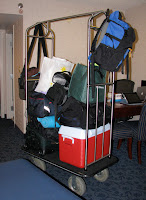There is no shame in building nailed furniture.

It's been with us a long time. In fact, nailed furniture goes all the way back to the Egyptians.
But, according to
Adam Cherubini in his presentation at WIA on nailed furniture, it was in 1632 when the Worshipful Company of Joyners of London managed to have standards for joinery passed into law. These standards gave them exclusive rights to certain types of joinery, to the exclusion of carpenters.

Only joyners were allowed to use complex methods such as dovetails, mortise and tenon, and frame and panel construction.
This left carpenters with few joinery options for the furniture they built—mechanical fasteners, tongue and groove, lap joints, dados, grooves, and rabbets.
Adam explained that it's common to find centuries-old 6-board pieces such as chests, stools, and trays that are joined with nails. You can also find examples of writing slopes, hanging cupboards, bedsteads, tables, and large hutches that are held together with nails.

Carpenters had to think outside the box. They nailed thin strips onto a flat panel to simulate frame and panel construction. They dressed up their pieces with simple moulding, corner and quirk beads, and roundovers.

"This is serious woodwork," Adam tells us. And it is. You need solid skills such as sawing, planing, drilling, and hammering nails without kinking them. There is also the challenge to make the piece look appealing without using all the bells and whistles found on high end pieces.
Do all our pieces have to be equally difficult to build? Who are we trying to impress? When was the last time a non-woodworker (who isn't a loved one who's been trained to notice) remarked on your fine English dovetails? More often than not, they comment on the shape of the piece, the appearance of the wood, and the finish.

Sure, we love the challenges and pride that come from cutting tricky joinery. And many pieces require complex joinery to be period-correct, to match their fancy design, or to be bomb-proof.
But building with nails is a blast.
When I got home from the conference, I remembered a couple pieces I had made that were completely assembled with nails. They were fast and fun to build and they have an honest charm. I built a sweater cupboard in a few hours and it's held up for over 15 years. The dogs' toy box is beaten up but the joinery is solid.
Adam showed us how to properly install nails without splitting the wood. It's a genuine skill, and one that we should pass along to the next generation. Moreover, rose head, clincher and cut nails are just plain cool-looking. And shell bits, nose bits and brad awls are extremely fun to use.
Adam suspects that there will be a trend in nailed furniture because the reproduction market isn't very good right now.

He believes you can make a living at building nailed furniture. And even if you're a hobbyist like me, you might find that the nailed pieces that you built in an afternoon get more attention than those finely dovetailed keepsake boxes you spent days making.
Maybe—sometimes—we work harder than necessary and focus on the joinery rather than joy of the craft.
 If you're like me, you have books and magazines all over your house tucked away in various nooks and crannies. So, when I gathered them all together I realized I needed another bookshelf.
If you're like me, you have books and magazines all over your house tucked away in various nooks and crannies. So, when I gathered them all together I realized I needed another bookshelf. This meant that I had the opportunity to use the new Lie-Nielsen tongue & groove plane* that I bought at a recent hand tool event. What a fun handplane! It's an ingenious design and works perfectly.
This meant that I had the opportunity to use the new Lie-Nielsen tongue & groove plane* that I bought at a recent hand tool event. What a fun handplane! It's an ingenious design and works perfectly. 




















